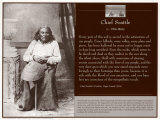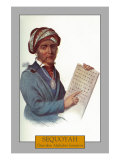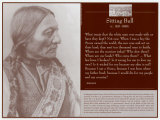|
|
|
|
|
|
|
|
|
|
|
|
BOOKS ABOUT NATIVE AMERICAN CHIEFS
|
|
|
|
|
|
|
|
|
|
|
|
|
|
|
|
|
|
|
|
|
|
 |
|
|
|
|
|
|
Sacagawea (also Sakakawea, Sacajawea)
b. c. 1788; present day Idaho
d. 12-20-1812 ?; present day North Dakota
Sacagawea, a Lemhi Shoshone woman who acted as an interpreter and guide for the Lewis and Clark Expedition, traveled thousands of miles from North Dakota to the Pacific Ocean between 1804 and 1806.
As a twelve year old she had been kidnapped from her home area and taken to a Hidatsa village. Sacagawea was then taken as a wife by a French trapper named Toussaint Charbonneau and her knowledge of the Shoshone language secured his being hired by the Expedition over the winter of 1804-05 at the encampment called Fort Mandan.
Sacagawea was a valuable member of the group - her presence as the mother of an infant son, Jean Baptiste Charbonneau, nicknamed “Little Pomp”, served as a signal of the peaceful intentions of the Expedition.
FYI - Sacagawea was given voting rights, along with the African American slave York, in the decisions of group. She insisted on her right to see the whale that washed ashore.
• Sacajawea (Lewis & Clark Expedition)
|
|
|
|
Buffy Sainte-Marie
b. 2-20-1941; Saskatchewan, Canada
Singer-songwriter, musician, composer, visual artist, pacifist, educator, social activist, and philanthropist Buffy Sainte-Marie focuses on issues of Indigenous peoples of the Americas.
• Buffy Sainte-Marie Music
Buffy Sainte-Marie quotes ~
• “He's the one who gives his body
as a weapon to a war
and without him all this killing can't go on
He's the universal soldier
and he really is to blame
His orders come from far away no more
They come from him, and you, and me
and brothers can't you see
this is not the way we put an end to war.”
Universal Soldier
• “I believe that people do want to know each other. I think it's always about the deep longing for respect.”
• “Language and culture cannot be separated. Language is vital to understanding our unique cultural perspectives. Language is a tool that is used to explore and experience our cultures and the perspectives that are embedded in our cultures.”
|
|
|
|
Chief Seattle
(c. 1786-1866)
Poster Text: “Every part of this soil is sacred in the estimation of my people. Every hillside, every valley, every plain and grove, has been hallowed by some sad or happy event in days long vanished. Even the rocks, which seem to be dumb and dead as they swelter in the sun along the silent shore, thrill with memories of stirring events connected with the lives of my people, and the very dust upon which you now stand responds more lovingly to their footsteps than yours, because it is rich with the blood of our ancestors, and our bare feet are conscious of the sympathetic touch.”
Chief Seattle’s Oration, Pugit Sound (1854)
Chief Seattle was the leader of the Suquamish and Duwamish tribes of the Puget Sound region of the Pacific Northwest. The Suquamish and Duwamish did extensive trading with white men in the area, and Chief Seattle had a geat deal of contact with them. Chief Seattle knew that his tribe was dying from disease and war. He wanted to find a way for the white people and the Suquamish and Duwamish to live peacefully, but his tribe's well-being and lands were sacrificed to please the whites and maintain peace.
• Seattle
|
|
|
|
|
|
|
Leon Shenandoah
b. 5-18-1915
d. 7-22-1996
Leon Shenandoah, as Chief of the Chiefs of the Six Nations Iroquois Confederacy, was the keeper of the central fire.
‘The fire that never dies’ is a symbol for a tradition that began centuries ago when a man they called the Peace Maker persuaded them to make a ‘Great Peace’ by forming a confederacy among themselves, based on a ‘Great Binding Law.’
He taught them that the way to overcome their conflicts was through a greater perspective. He said, “Think not forever of yourselves, O Chiefs, nor of your own generation. Think of the continuing generations of our families, think of our grandchildren and of those yet unborn, whose faces are coming from beneath the ground.”
• Leon Shenandoah Tribute at peace4turtleisland.org
• The Heart Forest
• Discover Turtle Island Earth Day Celebration in KC, 1992
• To Become a Human Being: The Message of Tadodaho Chief Leon Shenandoah
Chief Leon Shenandoah held the Onondaga title of Tadodaho for 25 years.
“My energy grows, my mind settles, and my heart smiles; for here, in the Heart of America, the people care for one another and their Earth.” Chief Leon Shenandoah, visiting KC in 1987
|
|
|
|
Shanawdithit
b. c. 1801
d. 6-6-1829; St. John's, Newfoundland (tuberculosis)
Shanawdithit was the last recorded surviving member of the Beothuk people who lived throughout the island of Newfoundland.
|
|
|
|
Sitting Bull (c. 1831-1890)
Poster Text: “What treaty that the white man ever made with us have they kept? Not one. When I was a boy the Sioux owned the world; the sun rose and set on their land; they sent ten thousand men to battle. Where are the warriors today? Who slew them? Where are our lands? Who owns them? ... What law have I broken? Is it wrong for me to love my own? Is it wicked for me because my skin is red? Because I am a Sioux: because I was born where my father lived: because I would die for my people and my country?” Statement
Hunkpapa Lakota Sioux chief and holy man Sitting Bull lead a band of Sioux Indians who resisted all of the U.S. government's attempts to change the way the Sioux traditionally lived. The U.S. government eventually drove Sitting Bull's people out of their homelands around the Black Hills of present-day South Dakota, but not without a fight. In 1876, Sitting Bull's tribe defeated the U.S. government's forces in the Battle of the Little Big Horn, in which Colonel George Armstrong Custer was killed. Sitting Bull's tribe later retreated to Canada. Starving and cold, tribe members surrendered to the U.S. government several years later. Sitting Bull was killed in 1890 when tribal police tried to arrest him at his home on the Standing Rock Reservation.
“What law have I broken? Is it wrong for me to love my own? Is it wicked for me because my skin is red? Because I am a [Lakota]; because I was born where my father lived; because I would die for my people and my country?”
Sitting Bull, 1877
• South Dakota posters
|
|
|
|
Squanto (Tisquantum)
b. c. 1580s; area of present day Plymouth, Massachusetts
d. November, 1622
Tisquantum, better known by the anglicized Squanto was a member of the Patuxet Tribe, part of the Wampanoag tribal confederation, who was kidnapped in 1614 by one of Captain John Smith lieutenants, and taken to Spain as a slave. Rescued by friars he eventually made his way back to New England only to find his tribe wiped out by smallpox.
Squanto then settled with the Pilgrims at the site of his former home, teaching them to farm in the New England soil and climate as well as hunt. He is often associated with Thanksgiving.
|
|
|
|
|
|
|
|
|
|
Jake Swamp
b. 1942
d. 2010
Jake Swamp, a chief of the Mohawk, is planting trees throughout the world with a message of harmony to all nations. As founder of the Tree of Peace Society, he continues a tradition which began centuries ago.
When endless wars and blood feuds had brought five nations to anarchy and despair, a man called the Peacemaker persuaded them to make a 'Great Peace' by forming a confederacy among themselves, based on a 'Great Binding Law'.
With all of the 50 chiefs of the first grand council assembled, the Peacemaker planted the original tree of peace, beneath which they buried their weapons of war. All nations were invited to take shelter beneath the tree.
• Jake Swamp planting tree in Kansas City, World Peace Celebration, 1988.
• Tree of Peace Society
|
|
|
previous page | top | next
List Notable Native Americans > a | b | c | d-e-f-g | h-i-j | k-l | m | n-o-p-q | r | S | t-v-w-x-y-z
|
|
I have searched the web for visual, text, and manipulative curriculum support materials - teaching posters, art prints, maps, charts, calendars, books and educational toys featuring famous people, places and events - to help teachers optimize their valuable time and budget.
Browsing the subject areas at NetPosterWorks.com is a learning experience where educators can plan context rich environments while comparing prices, special discounts, framing options and shipping from educational resources.
Thank you for starting your search for inspirational, motivational, and educational posters and learning materials at NetPosterWorks.com. If you need help please contact us.
|
|
|
|


























